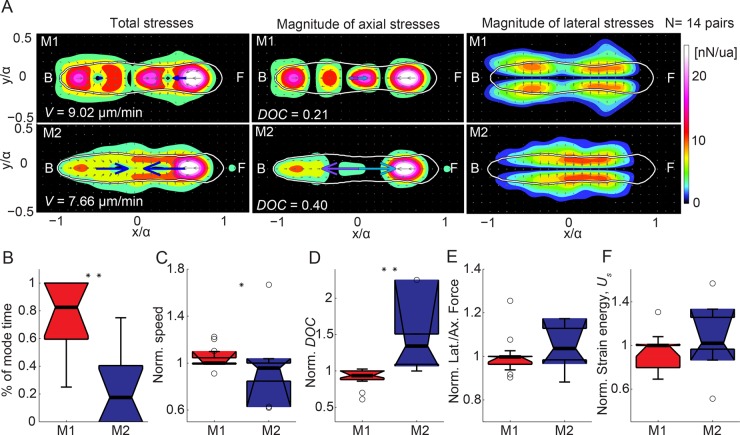FIGURE 3:
Average motility characteristics of locomoting tandem pairs in modes 1 and 2. (A) Mode-average traction stress maps (nanonewtons/unit area) in the pair-based reference frame for 14 pairs migrating by alternating between modes 1 and 2. Each row corresponds to a different mode as indicated. Left, middle, and right: magnitude of the total, axial, and lateral traction stresses, respectively, for each mode. The color patches indicate the magnitude of the stresses, and the gray arrows denote their direction. Blue arrows indicate the mean net axial force generated by each cell of the pair assuming that the contact line between cells is in the middle of the pair. Purple and cyan arrows indicate the mean force exerted by the leading cell on the trailing cell and vice versa. The white contours show the average shape of the pair. The front (F) and back (B) of the pair are indicated. Mode average speed (V) and degree of coupling (DOC). (B–F) Boxplots of motility parameters corresponding to modes 1 (M1, red) and 2 (M2, blue) for 14 pairs. Each parameter is normalized with its mean value for each pair. (B) Percentage of time spent in mode 1 vs. 2. (C) Speed of migration (V). (D) DOC between the cells of the pair. (E) Ratio of lateral to axial force (Fy/Fx). (F) Total strain energy imparted by the pair (Us). Circles represent outliers, and the notched section of the boxplots shows the 95% confidence interval around the median (Wilcoxon–Mann–Whitney test). One or two asterisks denote statistically significant differences between the medians of two distributions (<0.05 or <0.01, respectively; Wilcoxon rank sum test; see also Supplemental Figure S2).

